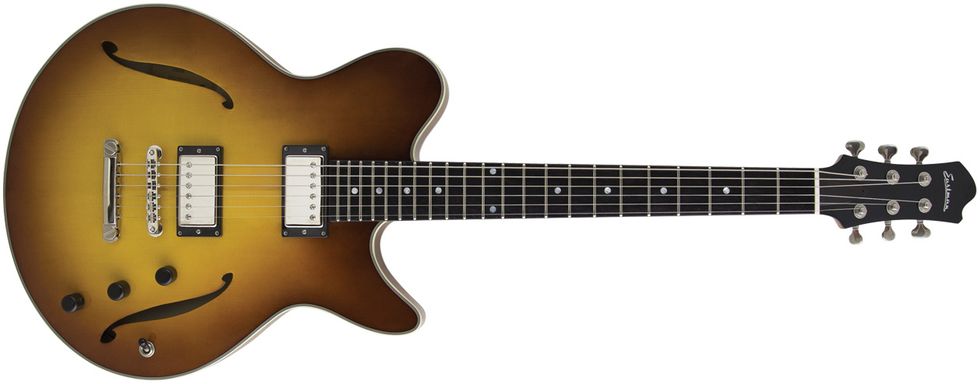RatingsPros:Cool and original design. Superb parts and materials. Ultra-versatile voice. Cons: Uneven tone pot taper. Street: $2,342 Eastman Romeo eastmanguitars.com | Tones: Playability: Build/Design: Value: |
Sometimes it feels as if Eastman’s Romeo (which is made in China) was specifically designed to defy conventional notions about import guitars. A knockoff of an existing design? Hardly! This instrument is unique in look and feel. Generic, cheaply made parts? No way! All hardware here is from premium American and Japanese manufacturers. A low-cost, bang-for-the-buck instrument? Not exactly. A long-term relationship with Romeo will set you back $2,342.
Is there an emerging trend here? Just last month we reviewed the Comins CGS-16, a terrific Korean archtop with an even loftier $2,399 price tag. At the very least, builders like Comins and Eastman are upending expectations about Asian production guitars.
What’s in a Name?
The Romeo is a svelte semi-hollow with a distinctive body shape. Its asymmetrical double cutaway has an ES-335-like scoop on the bass side and something closer to a Fender horn on the treble side. The wavy headstock reflects the unconventional contours. That body is smaller than it may seem in photos. It’s a mere 1.75"deep, and only 14.75" across the lower bout. The guitar is light, too: just 5.5 pounds. Romeo’s f-holes terminate far closer to the body’s edges than on, say, Gibson f-hole guitars. There’s a wooden block beneath the bridge, but no body-length center block as on a 335.
Aside from the scaled-down body, Romeo takes multiple cues from Gibson. Scale length is 24.75" and the fretboard radius is 12". The bone nut’s width is 1 11/16". The lovely burst stain is reminiscent of an old Les Paul. The finish isn’t poly, but old-fangled nitrocellulose.
That Which We Call a Rose
The Romeo’s top is solid spruce with even and attractive grain. The back and sides are mahogany laminate, ringed by immaculate ivoroid binding (5-ply on the top, 3-ply on the back). The neck’s heel is also clad in ivoroid, recessed about 1/8" from the back, and home to the strap button. This is significant, because the 1-piece mahogany neck is heavy relative to the lean, light body—enough so that you’d experience serious neck dive if the strap button were affixed to the upper bout. But with the button on the heel plate, everything balances beautifully, even without your forearm resting on the lower bout. There’s nothing janky about the heel-mounted button. ES-335s and many other hollow-and semi-hollows use the same configuration. (Eastman says they will move the strap button to the upper bout on future versions).
All hardware is top-shelf: The controls (volume/tone/tone) have sexy ebony dome knobs. Gotoh made the tuners, tailpiece, and Tune-o-matic-style bridge. The pots are by CTS. The input jack and pickup selector are from Switchcraft. The pickups are Lollar Imperials, which are among the finest PAF-influenced humbuckers.
Romeo, Romeo, Romeo! I Drink to Thee
There’s much Gibson DNA in Romeo’s specs and sonics. The guitar is certainly capable of warm, fat tones, but it can also get quite bright. Unplugged, the tone is zingy and present, with fine natural sustain. The Lollar pickups emphasize that snappy quality. Like any good PAF-influenced humbuckers, these can veer from chunky to sparkly, depending on your guitar, pedal, and amp settings. Imperials are slightly “hi-fi” relative to strictly vintage PAFs. Not in a sterile way. You simply have access to slightly brighter highs and slightly tighter lows.
You can hear that versatility in my demo clip, which features tones ranging from tubby chunk to screechy fuzz. I recorded through a Carr Lincoln, a Vox-influenced EL84 combo that emphasizes those aggressive highs. You encounter Romeo’s innate voice at 1:27, in a jazzy passage recorded direct to DAW with no amp. It’s still bright, though you can easily dial it back with the tone pot. But note that the tone pot’s taper is a bit odd, yielding a relatively modest treble cut in the first two-thirds of its range, and then darkening suddenly in the final third.
The C-shaped neck is chunky yet comfy. The ebony fretboard is glassy smooth. Jumbo frets (.104" x .047") contribute to the neck’s substantial feel. The elegant cutaways are easy to navigate. This is definitely an upscale playing experience. Romeo arrives clad in a classy hardshell case too.
The Verdict
Eastman’s Romeo is full of surprises, and not just because it defies stereotypes regarding made-in-China guitars. It’s a unique design built from fine woods and premium third-party hardware. The voice is Gibson-esque, but with uncommon access to crispy/articulate colors. Given Romeo’s unconventional proportions, this is probably a guitar you should audition in person before committing. But to many players, this rose will smell pretty damn sweet.




























